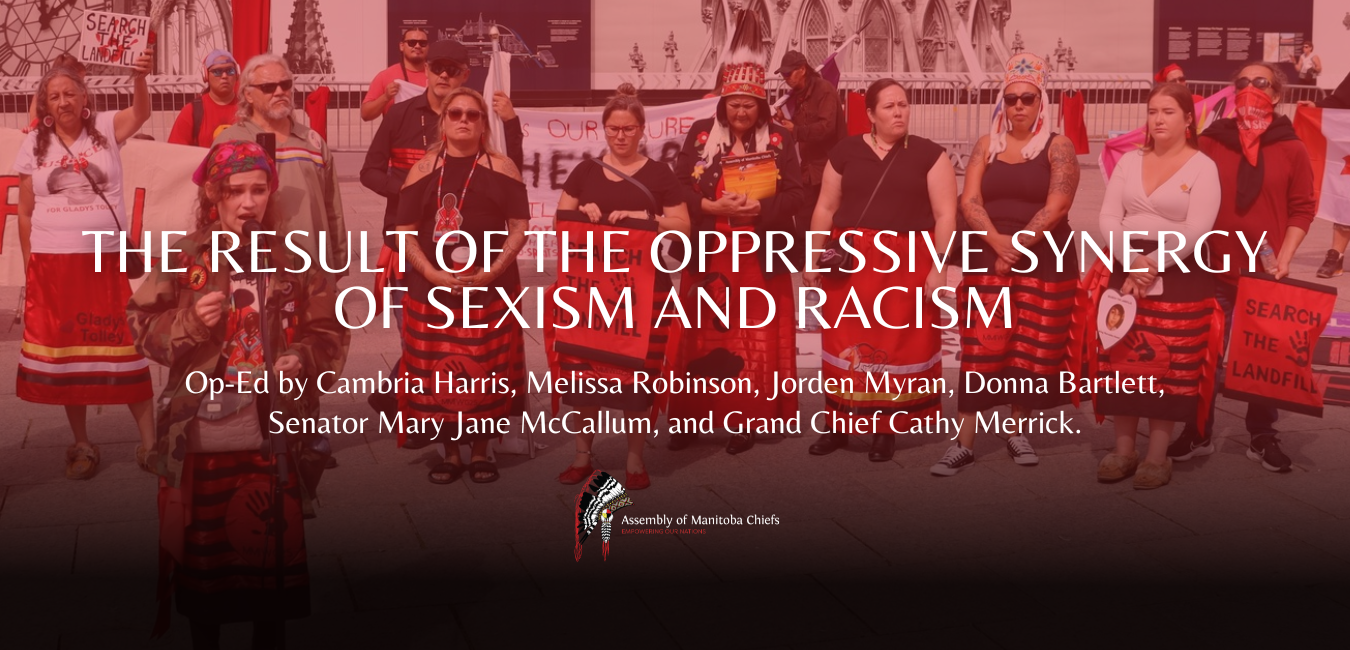The result of the oppressive synergy of sexism and racism

April 29, 2024
Treaty One Territory, Manitoba
AMC Communications
The families of Morgan Harris and Marcedes Myran have been involved in a long battle to search a Winnipeg landfill for their loved ones’ remains. These families warn that women, girls, and gender-diverse individuals find themselves in precarious situations, seeking shelter and safety in a province that historically offers little refuge.
Op-Ed by Cambria Harris, Melissa Robinson, Jorden Myran, Donna Bartlett, Senator Mary Jane McCallum, and Grand Chief Cathy Merrick. The Hill Times, April 29, 2024 (LINK)

“Economic and racial inequality are not abstract concepts, (they) hospitalize and kill even more people than cigarettes,” said Larry Adelman, executive producer of the 2008 documentary Unnatural Causes. “The wages and benefits we’re paid, the neighbourhoods we live in, the schools we attend, our access to resources and even our tax policies are health issues, every bit as critical as diet, smoking and exercise. The unequal distribution of these social conditions, and their health consequences are not natural and inevitable,” said Adelman. “They are the result of choices that we, as a community, as states, and a nation have made, can make differently. Other nations already have, and they live longer, healthier lives as a result.”
Although there is ample evidence of the centuries-long brutal treatment and genocide of innocent Indigenous Peoples, Canadians are immersed in biased information that leads to stereotyping. The continued perpetration of stereotypes of Indigenous Peoples—especially women—leads to prejudicial thinking. When we fail to correct a wrong—like searching for the women in the Winnipeg landfill—then we are practising discrimination. When our discriminatory actions and inactions are supported and condoned by governments, police, and other institutional structures, this process constitutes oppression. Racism of this type remains deeply and systematically rooted, as the power to make decisions, to take collective action, and to allocate resources resides at this level.
Oppression does not operate in isolation. In our country, white women won the right to vote in elections in 1918, but they were not recognized as persons until 1929. Canadian women of Asian and Indo-Canadian heritage were not enfranchised until 1947. And women of this country, Indigenous women, could not vote until 1960. As the disenfranchisement of Indigenous, Asian, and Indo-Canadian women demonstrates, the oppression of sexism and racism form a powerful synergy in disadvantaging women of colour in Canada, particularly Indigenous women.
First Nations women were revered as the backbone of their communities in pre-colonial times, but that has since been diluted or erased by the institutions of government and church. These women were symbols of strength and resiliency, same as they are today, for how else could we have survived years of genocide?
The families of Morgan Harris and Marcedes Myran have been involved in a lengthy battle to search the Prairie Green Landfill in Manitoba for their loved ones’ remains. These families warn that women, girls, and gender-diverse individuals find themselves in precarious situations, seeking shelter and safety in a province that historically offers little refuge. The ripple effect of this vulnerability increases the risk of addiction and mental health conditions disproportionately for those marginalized citizens.
Many find themselves at risk on the streets, and the path to recovery through rehabilitation facilities is laden with obstacles, including lengthy, agonizing wait times. The lack of housing and safe spaces remains a critical issue, pushing many to be homeless with belongings reduced to a size that vulnerable citizens can carry on their backs. The stark reality emphasizes the gravity of the situation: shelters, ostensibly places of refuge, are no longer secure havens. Instead, they have been transformed into predatory grounds, as seen in tragic cases like that involving accused serial killer Jeremy Skibicki, who has claimed the lives of four vulnerable First Nations women.
The racism that we live with is inscribed on our bodies and minds including high rates of heart disease, breast and cervical cancer, diabetes, and so on. Yet, race has absolutely no scientific meaning. Race is merely a social construction and is defined as “an ideology of inferiority that is used to justify unequal treatment (discrimination) of members of groups defined as inferior by both individuals and societal institutions.” Why, then, is race allowed to keep our women in the landfill?
What and who are creating these risks for “at-risk people?” What are the social pathogens that threaten their lives? This modern-day social murder causes certain groups—homeless, Indigenous Peoples—to persistently suffer more, and to die earlier. Women meet too early and unnatural deaths at the hands of various institutions that also impact other women by depriving them of the necessities of life across this country. As a result, they, too, are placed under threat of untimely death.
These women have been disowned by their country, and they continue to be disowned—even in death. First Nations women have to fight to find their place in this world. Are we, as First Nations women, not viewed as human beings deserving respect, including proper burials?
Cambria Harris, Melissa Robinson, Jorden Myran, and Donna Bartlett are family members of Morgan Harris and Marcedes Myran. Non-affiliated Senator Mary Jane McCallum is a citizen of the Barren Lands First Nation in Brochet, Man., and Cathy Merrick is the grand chief of Assembly of Manitoba Chiefs.
Read this Article on the Hill Times Website: